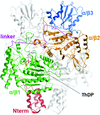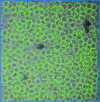issue contents
July 2020 issue

editorial
CRYO | EM
The application of cryo-EM methods to study SARS-CoV-2 proteins provides a convincing demonstration of the power of cryo-EM in the arsenal of structural biology.
scientific commentaries
CHEMISTRY | CRYSTENG
The present paper indicates that helium has more in common with the alkaline earths than is often considered. Not only does it share an analogous electron configuration but it also has an analogous crystal structure to that of beryllium and magnesium which is, in contrast, characteristic of the bulk material rather than of isolated atoms.
MATERIALS | COMPUTATION
The results of Roth et al. [IUCrJ (2020). 7, 673–680] provide a clear picture of occupational correlations in half-Heusler compounds.
lead articles
CHEMISTRY | CRYSTENG
Bond-length distributions are examined for transition metals bonded to O2−. Causal mechanisms underlying bond-length variation in inorganic solids are resolved, and the extent to which these mechanisms individually result in bond-length variation is quantified for transition metals with anomalous bond-length distributions.
topical reviews
BIOLOGY | MEDICINE
The history of the growth of the Protein Data Bank and the role that the community has played in developing standards and policies are described.
research letters
CRYO | EM
An electron microscope operating at a voltage of 200 kV is shown to be sufficient for determination of protein structures at high resolution using cryo-EM methods. The level of detail in the 1.8 Å map reported by the authors shows visible density bumps for hydrogen atoms and marks an important advance in the establishment of microscopes operating at lower voltages as powerful tools for structure-guided drug design using cryo-EM.
EMDB reference: β-galactosidase at ∼1.8 Å, EMD-21995
PDB reference: β-galactosidase at ∼1.8 Å, 6x1q
research papers
BIOLOGY | MEDICINE
A feasibility study on how the binding affinities of protein–ligand interactions are obtained, based on the solution scattering intensities of their respective titration series, is presented. Experimental parameters and their resulting influence on accuracy and precision are analysed.
MATERIALS | COMPUTATION
Download citation


Download citation


The spin dimer magnet NaCu2VP2O10 was discovered, and its crystal structure was determined using single-crystal X-ray diffraction and electron diffraction. Maximum magnetic susceptibility was observed at ∼60 K and NaCu2VP2O10 became non-magnetic upon further cooling.
CCDC reference: 1976933
BIOLOGY | MEDICINE
Polyspecific ligand recognition by P-glycoprotein includes compensatory mechanisms in the form of ligand-binding shifts when ligand-interacting residues are challenged by mutagenesis. Point mutations of ligand-interacting phenylalanine residues to alanines resulted in binding shifts of an environmental pollutant, yet its inhibitory function on ATPase activity was preserved.
PDB references: P-glycoprotein, C952A mutant, complex with BDE-100, 6unj; C952A/F979A mutant, complex with BDE-100, 6ujp; C952A/F724A mutant, complex with BDE-100, 6ujr; C952A/F728A mutant, complex with BDE-100, 6ujs; C952A/Y303A mutant, complex with BDE-100, 6ujt; C952A/Y306A mutant, complex with BDE-100, 6ujw
MATERIALS | COMPUTATION
Defective half-Heuslers, X1−xYZ, with different degrees of short- and long-range vacancy order can be explained using a simple model. In this model, the vacancies avoid being nearest or next-nearest neighbors. The model reproduces previously observed diffuse electron-diffraction data. The findings suggest a method for further improving thermoelectric efficiency of these materials.
BIOLOGY | MEDICINE
Application of the PAIREF program providing automation of paired refinement is demonstrated on six data sets. The results prove that the inclusion of high-resolution data beyond the conventional criteria can lead to more accurate structure models.
BIOLOGY | MEDICINE
Through interaction studies, the crystal structure of human DHTKD1 allows insight into a mitochondrial megacomplex in lysine catabolism. This creates the starting framework for developing DHTKD1 modulators to probe the intricate mitochondrial energy metabolism.
EMDB reference: EMD-11014
PDB reference: DHTKD1, 6sy1
CRYO | EM
This paper presents a detailed assessment of the performance of the CRYO ARM 300 electron microscope in a multiuser cryo-EM facility setting. It is shown that the microscope can be used for reliable automated data collection. The strengths and weaknesses of the hardware are discussed.
EMDB reference: apoferritin, EMD-10675
CRYO | EM
A self-supervised workflow uses a 2D class average to progressively train a convolutional neural network for automated particle picking in cryo-EM.
BIOLOGY | MEDICINE
Download citation


Download citation


A method is presented to perform time-resolved X-ray crystallography with a 63 ms time resolution using a fast pixel detector and partial oscillation data sets. This minimizes the number of crystals (<100) required for a complete experiment.
BIOLOGY | MEDICINE
Crystal structures and a SAXS envelope model of the RsbV–RsbW complex reveal that the RsbW tetramer forms a core structure to regulate SigB activity.
BIOLOGY | MEDICINE
The crystal structures of HigA3 antitoxin and DNA-bound HigA3 allow detailed structural insights into the HigBA toxin–antitoxin system of Mycobacterium tuberculosis. The unique dimerization of HigA3 induces DNA bending.
MATERIALS | COMPUTATION
The oscillatory profiles of rocking curves and equal-thickness fringes were observed on nearly perfect protein crystals of ferritin, which matches predictions of dynamical diffraction theory.
BIOLOGY | MEDICINE
The crystal structure of the N-terminal membrane anchoring domain of mycobacterial DivIVA/Wag31 reveals a filament-compatible `dimer-of-dimers' assembly state. The results suggest that, in addition to lipid binding, the N-terminal of Wag31 can participate in self-assembly to form filamentous structures.
PDB reference: Structure of the N-terminal domain of Wag31, 6lfa
SASBDB reference: N-terminal domain of Wag31 from M. tuberculosis, SASDHH4
addenda and errata
BIOLOGY | MEDICINE
Corrigendum to the article by Casino et al. [IUCrJ (2018). 5, 765–779].



 journal menu
journal menu




 access
access

































